There are 51 different types of snakes in Illinois with only 5 of the them being venomous and harmful to humans. Marshes and rivers allow for many different water snakes to live in the state.
The forrests, prairies, woodlands and fields also house many snakes. You may find some live near humans, and other species go out of their way to avoid us. Habitats, general location and date can affect what you see on your herping adventures.
Each snake on this list has traits that can help define it from other species. Coloring, scales, size and patterns are factors to look at when trying to identify a snake.
Some of the differences between snakes are small and easy to miss. Misidentification is the death of many snakes. Lists and resources can help you know what snake you are looking at.
Herping in Illinois is exciting when you know what to look for. Some snakes burrow and spend their time underground or hiding. Water snakes perfer water and are not likely to be away from a source. Knowing your snakes can be useful when looking for them. Here are the 50 snakes that can be found in Illinois useful facts about each.
Table of Contents
Snakes In Illinois
1. Southern Copperhead
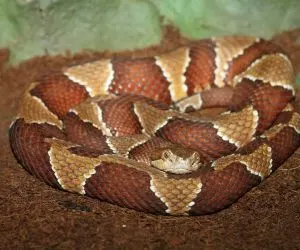
- Experience Level: Intermediate-Advanced
- Family: Viperidae
- Scientific Name: Agkistrodon Contortrix Contortrix
- Other Names: copperhead
- Adult Size: 2-3 Feet Long
- Lifespan: 25 years
- Average Price Range: $100 – $300
Southern Copperheads are a subspecies of the copperheads that can be found in Illinois. This snake is adaptable to a wide range of habitats and can live in wooded forests, wetlands, grassy fields, rocky mountains and outcrops.
Copperheads are medium sized with reddish tan heads. Their bodies can be brown or tan, and are marked with dark hourglass shaped bands that go down to its tail. These hourglass shaped bands are unique to the species and can help you identify it from other similar snakes.
Large triangle shaped heads and catlike eyes are traits it shares with other venomous species. Bites can be dangerous, but are rarely fatal due to its smaller fangs and less potent venom. Copperheads mainly use their venom to hunt and feed off of mice, snakes, birds, amphibians and insects.
2. Northern Copperhead
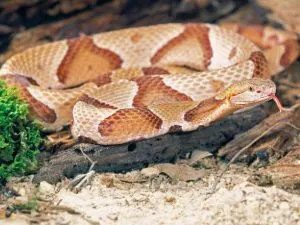
- Experience Level: Intermediate-Advanced
- Family: Viperidae
- Scientific Name: Agkistrodon Contortrix Mokasen
- Other Names: copperhead
- Adult Size: 2-3 feet long
- Lifespan: 25 years
- Average Price Range: $100-$300
Northern Copperheads are the other subspecies of copperhead that reside in Illinois. Similar in appearance with their Southern variant, they are tannish brown, with redheads and have dark hourglass bands going down their body.This species has darker bands, with brown markings that appear around their face, chin and eyes.
Common habitats to find them include forests, grasslands, and swamps. Their camouflage allows them to better blend in with rocky areas and deserts, which is also where they inhabit.
While venomous, copperheads can still make great pets for experienced and confident snake owners. They have long lifespans and are docile when handled.
Copperheads only need to be fed once every two weeks, usually a small mammal, and are low maintenance pets. If kept as a pet or seen in the wild you should still be cautious.
This snake gives no induction when they are about to strike, which is a main reason why they account for more snake bites than any other venomous species in North America.
3. Midwestern Worm Snake
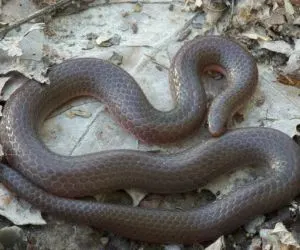
- Experience Level: Beginner-Intermediate
- Family: Colubridae
- Scientific Name: Carphophis amoenus
- Other Names: worm snake
- Adult Size: 7.5-13 inches
- Lifespan: 4 years
- Average Price Range: $15
The Midwestern Worm Snake is a small, worm-like snake that spends most of its time underground. Its scales are glossy and range in colors from brown to black. On the top of its small head are two large scales between the eyes and nose, and its belly is a pink or reddish color.
Wetter habitats with wooded and grassy areas is where this snake makes its home. When dry spells occur they go deep underground.
When spring comes along they can sometimes emerge from hiding under logs, leaves and other natural debris. These snakes survive off mostly earthworms and are preyed upon by other snakes, birds and small mammals.
4. Western Worm Snake
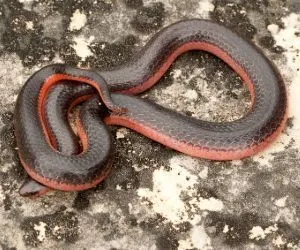
- Experience Level: Beginner – Intermediate
- Family: Colubridae
- Scientific Name: Carphophis Vermis
- Other Names: worm snake
- Adult Size: 7.5-11 inches
- Lifespan: 4 years
- Average Price Range: $15
The Western Worm Snake is a small snake. Black or dark brown is it’s body color and orange, red, or pink scales sit on their belly. They can be distinguished from other small snakes in the area by the sharp scale at the tip of its tail and their distinct two-toned coloration.
These snakes make their homes in bluff prairies, savanna remnants, and open woodlands.Western Worm snakes are highly secretive and can be found under leaf litter, partially embedded rocks, and underground when the surface soil temperature rise. While their diets mainly consist of earthworms they are also known to eat other elongated invertebrates.
5. Northern Scarlet Snake
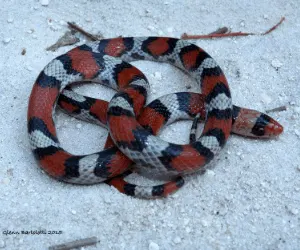
- Experience Level: Advanced
- Family: Colubridae
- Scientific Name: Cemophora coccinea copei
- Other Names: False coral snake, milk snake
- Adult Size: 14-20 inches
- Lifespan: 20-30 years
- Average Price Range: $36-$50
Northern Scarlet snakes are small, tri-colored snakes patterned with black, red, yellow or white bands with red generally being the largest band. This species can be distinguished by its bands not wrapping completely around, leaving its underside solid pink, white, or light gray. It also had a pointed snout.
This snake spends most of its life underground and is rarely found in day-light. During the day they hid under logs, leaf litter, rocks and other debris.
These snakes prefer areas such as pine forests, where the soil is well drained and sandy. Northern Scarlet snakes feed off the eggs of other reptiles and occasionally consume small animals such as lizards, frogs, and small snakes.
Like other harmless tri-colored snakes in the U.S. the Northern Scarlet snake pattern has been thought to mimic the venomous coral snake to ward off predators. Scarlet snakes are non venomous and rarely bite when handled.
6. Kirtland’s Snake
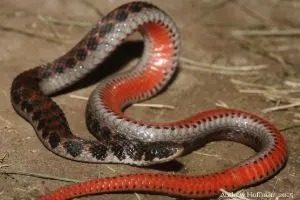
- Experience Level: Advanced
- Family: Colubridae
- Scientific Name: Clonophis kirtlandii
- Other Names: Cora Kennicott’s snake, kirtland water snake
- Adult Size: 14-20 inches
- Lifespan: 1-5 years
- Average Price Range: N/A
The Kirtland’s Snake is a small reddish to dark brown snake with a red, pink, or orange belly. It can be distinguished by its bright underside that is lined with a row of dark spots on either side. Its head is completely dark brown or black with white or yellow scales on its chin and throat.
Kirtland Snakes can be found in open wetlands or along the edges of forested wetlands and floodplains. These snakes make their homes in crayfish and other animal burrows, and can usually be found under leaf litter, logs, rocks and other debris.
On occasion this species has also been found in open habitats near urban areas such as grassy open parks, cemeteries, and vacant lots.
Kirtland’s snakes are usually quite small so their prey is as well. They feed upon snails, slugs and earthworms.They are non venomous and are not known to be aggressive when handled.This species is currently facing extinction due to factors such as habitat loss, climate change, and groundwater overuse.
7. Southern Black Racer
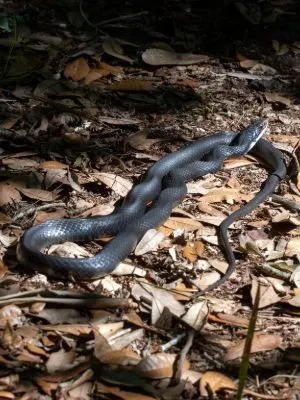
- Experience Level: Advanced
- Family: Colubridae
- Scientific Name: Coluber constrictor priapus
- Other Names: Black racer
- Adult Size: 20-55 inches
- Lifespan: 10 years
- Average Price Range: $25-$40
Southern Black Racers are a species that can be found throughout the eastern parts of NorthAmerica. They are grey with brown spots when young and grow to be all black. The jawbone of this snake is all white to match its belly.
Racers are fast and will usually flee when spotted. They are a very common species and can live in a variety of habitats. These snakes are most active during the day and in warmer weather. As it cools and turns to night they take refuge hiding under logs or in burrows.
Southern Black racers enjoy a varied diet of birds, eggs, lizards and other small animals.
8. Blue Racer
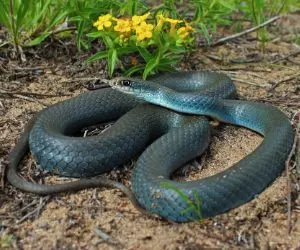
- Experience Level: Advanced
- Family: Colubridae
- Scientific Name: Coluber constrictor foxii
- Other Names: N/A
- Adult Size: 36-60 inches
- Lifespan: 10 years
- Average Price Range: $50-$100
The Blue Racer is a slender, smoothed skin snake with unique blue coloring. Black or blueish green coloring can occur and its stomach is a light white. It can live in a variety of habitats but prefers forests and edges of forest with open fields.
This snake’s fast speed helps it catch prey. Rodents and small mammals are its main diet but it is an opportunistic snake, feeding off of whatever it can get.
Blue Racers are active most during the daytime. They like to explore and climb around the earth’s foliage, but can spend most of their time underground.
This species can enjoy cooler weather and is seen sunbathing when temperature drops. Blue Racers are an uncommon species of Racer, and in some areas are known to be endangered.
9. Prairie Ringneck Snake
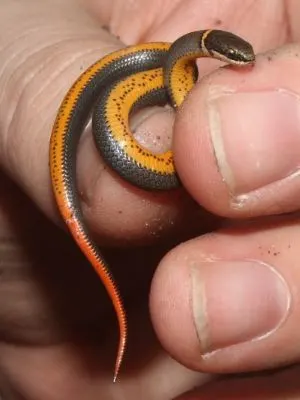
- Experience Level: Beginner
- Family: Colubridae
- Scientific Name: Diadophis punctatus arnyi
- Other Names: ringneck snake
- Adult Size: 10-14 inches
- Lifespan: 6-10 years
- Average Price Range: $30
Prairie ringnecks are a subspecies of ringneck snake that live around prairies and fields. They are dark in color, usually being grey or tan. Prairie ringnecks are small snakes, with round blunt heads. A yellow ring sits around its neck and its stomach is bright yellow with spots.
Common places to find them are underground or hiding under rocks, logs and natural debris.They can also be seen sunbathing or slithering in grass.
Ringnecks are active from spring to late summer. In winter they hibernate underground. Prairie ringnecks have a healthy population and are easily domesticated. Their docile nature and vibrant colors make them a popular pet.
10. Northern Ringneck Snake
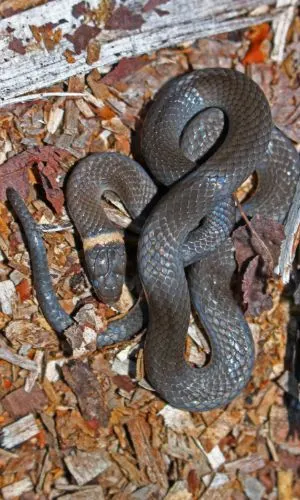
- Experience Level: Beginner
- Family: Colubridae
- Scientific Name: Diadophis punctatus edwardsii
- Other Names: Fodder snake, Collard snake
- Adult Size: 10-15 inches
- Lifespan: 6-10 years
- Average Price Range: $30
Northern Ringnecks snakes are a small, harmless species of ringneck that lives in forest type habitats in North America. They are grey or black with yellow rings around the neck. Its bright colors help keep predators away, but it can also emit a smelly musk if threatened.
Northern Ringnecks differentiate from other subspecies by having a ring that fully connects around its neck and no defined pattern. These snakes are most active from spring to early autumn.
They are mostly nocturnal and prefer to live in forests with lots of leaf litter and natural debris to hide under. They prey on small organisms like lizards, worms, salamanders and small snakes.
11. Mississippi Ringneck Snake
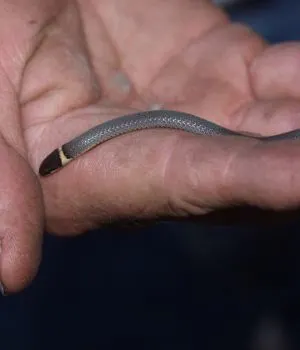
- Experience Level: Beginner
- Family: Colubridae
- Scientific Name: Diadophis punctatus stictogenys
- Other Names: ring snake
- Adult Size: 10-15 inches
- Lifespan: 6-10 years
- Average Price Range: $30
Mississippi RingNeck snakes live in pine forests, ravine bottoms, and timbered hillsides in the eastern part of the United States. They have blackheads with grey bodies, held together by a yellow ring.
These snakes are not dangerous and not aggressive when handled. They are venomous to their prey and administer it by chewing on them Lizards, salamanders and worms are what their diet mainly consists of.
These snakes are popular pets for beginners because of their small size, unique color and cool temper. Their inability to harm humans and easy care routine makes this species a solid choice for beginners.
12. Western Mud Snake
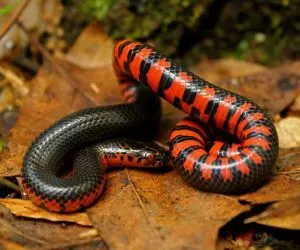
- Experience Level: Advanced
- Family: Colubridae
- Scientific Name: Farancia abacura reinwardtii
- Other Names: Mud snake
- Adult Size: 40-54 inches
- Lifespan: N/A
- Average Price Range: $80-$100
The western mud snake is a smooth black snake, with glossy scales. It’s stomach is a checkered pattern that is usually light orange to bright red. No other snake in Illinois has glossy black scales with red coloring.
This snake lives around creeks, rivers and ponds. It is semi aquatic and only leaves water for laying eggs, breeding and to escape a drought.
Mud Snakes survive off salamanders, tadpoles, frogs and other aquatic creatures. It uses its sharp tipped tail to prod the prey it chases. If picked up it will stab you with its tail, but this is harmless and cannot break skin.
This species is secretive and nocturnal. If seen it is usually in the water around thick vegetation, or crossing the road on a rainy night.
13. Dusty Hognose Snake

- Experience Level: Intermediate
- Family: Colubridae
- Scientific Name: Heterodon nasicus gloydi
- Other Names: Western Hognose, Plains hognose snake
- Adult Size: 14-36 inches
- Lifespan: 9-20 years
- Average Price Range: $200
Dusty hognose snakes are found in prairies, meadows, loose soil areas and brush habitats. It is pale brown or yellow with dark splotches going down its back.
Their stomach is black and without markings, and their scales are keeld and rigid. This snake’s nose is more sharply uptilted compared to its other subspecies.
Other snakes, toads, eggs and small rodents are a main part of the Dusty hognose snake’s diet. It uses its odd shaped nose to dig food out of the ground.
When threatened this species will flatten its head and strike at the enemy. It will not bite often. They are also known to play dead.
14. Eastern Hognose Snake
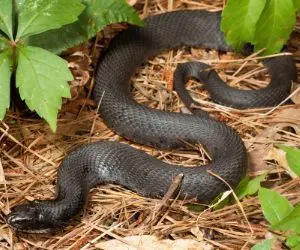
- Experience Level: Advanced
- Family: Colubridae
- Scientific Name: Heterodon platirhinos
- Other Names: Spreading Adder, Deaf Adder
- Adult Size: 28 inches
- Lifespan: 12 years
- Average Price Range: $150-$200
Eastern Hognose snakes are a non venomous, medium sized species found in the Central United States. They are known for their uptilted nose that looks similar in appearance to a pigs.
They can be many different colors like red, green, orange, brown, gray and black. Dark blotches are checkered and can be a pattern, but it can also be plain. Their stomachs are grey or light cream colored.
Eastern Hognose snakes live in woodlands, fields and framlands. They are sometimes kept as pets but not often due to their diet.
They mostly eat toads, frogs, salamanders and other amphibians. Head butting, playing dead and emitting a musk are its defensive behaviors.
15. Prairie Kingsnake
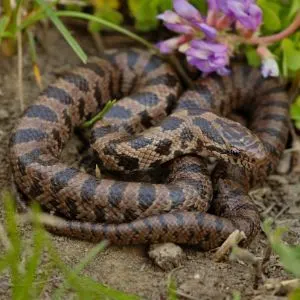
- Experience Level: Beginner-Intermediate
- Family: Colubridae
- Scientific Name: Lampropeltis calligaster
- Other Names: Yellow-bellied Kingsnake
- Adult Size: 29-43 inches
- Lifespan: 23 years
- Average Price Range: $50-$100
Prairie Kingsnakes are medium, with brownish and greenish grey coloring. They have dark blotches that are spread across its body outlined in black. At the top of their head is a v shaped marking and as they age they become darker.
These snakes can be found in prairies, wooded areas, fields and hillsides. They are hard to find but are very common.
Prairie Kingsnakes are most active from spring to fall and hide under debris like logs or rocks. They feed off of mice and other animals that live in their forests. They are harmless to humans and can adapt well to their presence.
16. Speckled Kingsnake
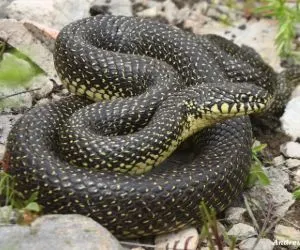
- Experience Level: Beginner-Intermediate
- Family: Colubridae
- Scientific Name: Lampropeltis getula holbrooki
- Other Names: salt and pepper snake
- Adult Size: 4-8 feet
- Lifespan: 10-20 years
- Average Price Range: $150-$200
Speckled Kingsnakes are easily recognizable by their glsosy scales with small dots on each scale. They can be brown to bluish black, with yellow bellies. The speckles are usually yellow and sometimes white.
This snake can be found in many habitats like prairies, bushy areas, hillsides, forest edges and swamps. They can hide in other animals’ burrows or under rocks and logs.
April to October is when these snakes are most active, and they are vital to help keep rodent populations low. Fish and other venomous species are also parts of their diet.
They are immune to other animals’ venom and poisons. Vibrating their tail and emitting a musk are the Kingsnakes defenses. They are harmless to humans and can make great pets.
17. Black Kingsnake
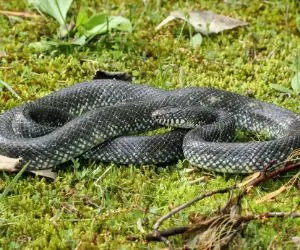
- Experience Level: Beginner -Intermediate
- Family: Colubridae
- Scientific Name: Lampropeltis getula niger
- Other Names: Eastern Kingsnake, Common Kingsnake, Chain Kingsnake
- Adult Size: 4 feet
- Lifespan: 15-25 years
- Average Price Range: $150-$250
Black Kingsnakes live in many forests, swamps and wooded habitats in North America. Areas near bodies of water are where they are likely to be found. It has a thick body, with smooth scales and large round eyes.
This Kingsnake is all black, with small yellow spots on its face and back. Their belly is a checkered color of black and white.
Black Kingsnakes are active during the day and can be found hiding under rocks and other natural debris. Their diet consists of eggs, snakes, lizards and small animals.
Kingsnakes are easily tamed and can make good pets. They are easily handled and can thrive in captivity.
18. Eastern Milksnake
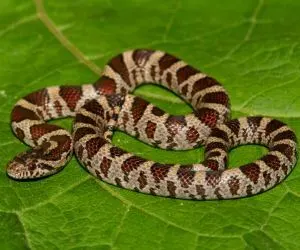
- Experience Level: Beginner
- Family: Colubridae
- Scientific Name: Lampropeltis triangulum
- Other Names: milk snake
- Adult Size: 24-36 inches
- Lifespan: 20 years
- Average Price Range: $100-$300
Eastern Milk Snakes are slender bodied, medium sized snakes that are spread across central North America. These snakes can come in many color variations.
It has heavy blotches over a base color. Its base can be brown, light gray and have dark red or brown blotches. Its belly is a black and white checkered pattern.
Fields, framland and wooded areas are places this snake makes its home. A common place to find this snake is in the barn of farms, since there are so many mice in there.
They also sunbath and can be seen climbing trees when it floods. When hotter temperatures come, these snakes go underground or under objects. Adult snakes eat mostly rodents and kill by constricting.
19. Red Milksnake
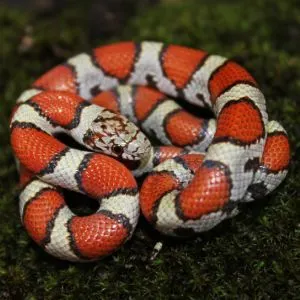
- Experience Level: Beginner
- Family: Colubridae
- Scientific Name: Lampropeltis triangulum syspila
- Other Names: milk snake
- Adult Size: 24-36 inches
- Lifespan: 20 years
- Average Price Range: $80-$150
Red Milk Snakes are medium size, with smooth scales. They live in North America and Illinois. Milk snakes have red saddles, with yellow bands surrounding on their back as a pattern. The large red blotch that sits on their head surrounded by black can help identify the species.
These snakes live in dry open fields and wooded areas. You can often find them taking refuge under objects and in burrows. They are nocturnal and are terrestrial snakes.
Bright colors, docile nature and non deadly bites make these snakes ideal pets for beginners. When they are younger they can be shy, but will adjust to human contact. Their diet is of mammals and small rodents.
20. Eastern Coachwhip

- Experience Level: Intermediate-Advanced
- Family: Colubridae
- Scientific Name: Masticophis flagellum
- Other Names: Coachwhip
- Adult Size: 42-60 inches
- Lifespan: 12-20 years
- Average Price Range: $150-$200
Eastern coachwhips are long and slender, reaching up to 72 inches. This snake is easily identifiable by its black head and neck. The black then fades to the snake’s base color which can be tan, reddish and even pink.
Coachwhips have large heads and strong jaws. This snake is found in open grassland and fields near creeks. They are active mostly during the day, and can withstand high temperatures.
These snakes eat whatever they can get like insects, small animals and eggs. If threatened this snake will usually try to run. They are not ideal pets, and will strike repeatedly if threatened.
21. Mississippi Green Water Snake
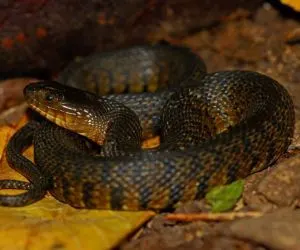
- ● Experience Level: Advanced
- ● Family: Colubridae
- ● Scientific Name: Nerodia cyclopion
- ● Other Names: Green water snake
- ● Adult Size: 30-45 inches
- ● Lifespan: 8-15 years
- ● Average Price Range: $20-$50
Mississippi Green water snakes live in marshes, ponds, streams and other bodies of water in the southern United States. Scales around their eyes help differentiate it from other water snakes.
This snake is thick and can be olive, dark green or brown in color. Markings sometimes appear on their body, and go away with age. On their stomach is markings of half moons.
Crayfish, frogs and fish are what this snake eats in the wild. Like other water snakes they give birth to live young, and mating begins in early spring. This water snake is sometimes confused with cottonmouth, but they are non venomous.
22. Plain-bellied Water Snake
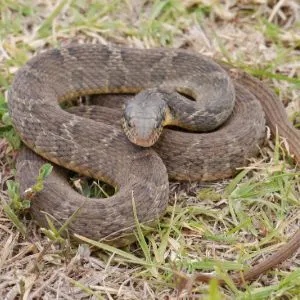
- Experience Level: Advanced
- Family: Colubridae
- Scientific Name: Nerodia erythrogaster flavigaster
- Other Names: Yellow belly water snake
- Adult Size: 30-48 inches
- Lifespan: 8-10 years
- Average Price Range: $50
Plain belly water snakes can be found in the Southeastern United States and near large bodies of water. Marshes, swamps and forests are some of the habitats they live in. They may choose to travel away from water during humid periods.
Large and thick, their colors can vary from gray, tan, or olive green with red coloring under their mouths. Dark blotches are common on this snake and their underside is yellow, brown, red or green with no markings.
Plainbelly water snakes are often confused with cottonmouths, but they are not venomous. They can be found basking in the sun and hanging from branches.
Their diet is mostly of frogs and tadpoles, sometimes fish. This snake is active during both day and night and will flee at the sight of a human.
23. Copperbelly Water Snake
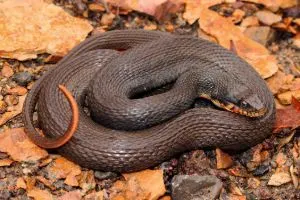
- Experience Level: Advanced
- Family: Colubridae
- Scientific Name: Nerodia erythrogaster neglecta
- Other Names: copperbelly
- Adult Size: 24-48 inches
- Lifespan: 8-10 years
- Average Price Range: $50
Copperbelly water snakes are a threatened species that lives in the central United. These snakes have a solid dark back. Usually grey, dark blue or black in color.
An easy way to identify them is by their bright copper colored stomach. These snakes live in marshes and wetland areas. Verniage wetlands is where the snake breeds and hunts.
The destruction of wetlands habitats and predators has caused this snake’s population to decline.
They are also commonly captured to be kept as pets due to their rarity. Frogs, tadpoles, salamanders and other water life are a main part of this snake’s diet. They can be seen hunting and eating in packs.
24. Southern Water Snake
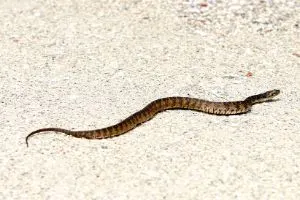
- Experience Level: Advanced
- Family: Colubridae
- Scientific Name: Nerodia fasciata confluens
- Other Names: Broad-banded water snake
- Adult Size: 22-42 inches
- Lifespan: 8 years
- Average Price Range: $20-$50
Southern Water Snakes are medium-sized, thick snakes that are found in the Southeastern United states. Mostly in the coastal plains habitat.
Their base color can be grey, tan, yellow or reddish brown and they darken with age. On their back lays a dark crossband pattern and occasionally a black line runs down their back.
These snakes are semi aquatic, and can be found in areas with large bodies of water. They feed off of frogs, fish, birds, and whatever small animal they can find.
Mostly active at night, they are not venomous or dangerous to humans. Water snakes make great pets as they are inexpensive and easy to care for.
25. Diamond-backed Water Snake
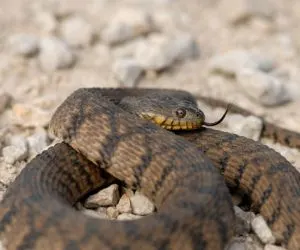
- Experience Level: Advanced
- Family: Colubridae
- Scientific Name: Nerodia rhombifer
- Other Names: Diamondback water snake
- Adult Size: 30-63 inches
- Lifespan: 9 years
- Average Price Range: $50
Diamondback water snakes are medium-sized, with greyish to brown bodies. With keeled and rough scales, they have a dark Diamond pattern running down it’s entire back. Younger snakes have these same markings and look no different.
This snake is found in the central United States, and is very common. They usually live near slow moving water and fields. It survives off a diet of fish, small animals and eggs. Hanging from trees and dipping into the water is a way it hunts.
Sharp teeth help keep hold of slippery fish. Their teeth can cause an extremely painful bite, but they are not dangerous.
26. Northern Water Snake
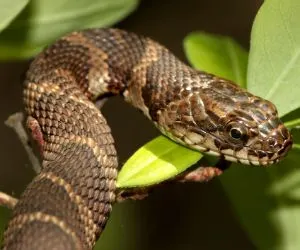
- Experience Level: Intermediate
- Family: Colubridae
- Scientific Name: Nerodia sipedon
- Other Names: Banded water snake
- Adult Size: 48-54 inches
- Lifespan: 9 years
- Average Price Range: $20
Northern water snakes live in water habitats and are found throughout North America. Rivers, streams, lakes, bogs, marshes and sloughs are some of the environments they enjoy. These snakes love open areas to sunbathe in, but will not stray too far from water.
Northern water snakes are dark colored, usually tan or gray. They have dark blotches(brown or black) that alternate to form bands. Some water snakes turn all brown or black when they age. Their stomachs are white, with crescent patterns on them.
These snakes are active day and night. Mice, rats, and animals found in water like frogs are preyed upon by this snake. They have been known to chase fish near land to eat and constrict them.
27. Midland Water Snake
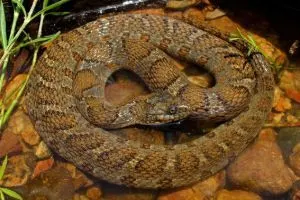
- Experience Level: Advanced
- Family: Colubridae
- Scientific Name: Nerodia sipedon pleuralis
- Other Names: common water snake
- Adult Size: 22-40 inches
- Lifespan: 9 years
- Average Price Range: $20
Midland water snakes are a medium sized aquatic snake that lives in the Southern United States. It is brown, with dark blotches going down it’s back.
Near the tail a checkered pattern begins to form. Its stomach has a crescent shaped pattern that gives the snakes stripes. Key features include round eyes and a thin body.
This snake lives in wetlands, marshes and swamp habitats, feeding off the aquatic life. It is one of the most common water snakes in Illinois and North America. They are not venomous, but will bite if threatened.
28. Rough Green Snake
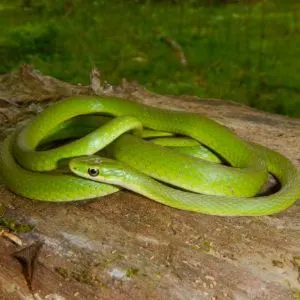
- Experience Level: Intermediate-Advanced
- Family: Colubridae
- Scientific Name: Opheodrys aestivus
- Other Names: Grass snake, Green grass snake
- Adult Size: 22-32 inches
- Lifespan: 8 years
- Average Price Range: $10-$30
Rough green snakes are small, long, bright green snakes with a yellow belly. They have rough keeled scales and large eyes. When they die their bright green coloring turns into a blue. They are timid and blend in with the environment to be left alone.
Rough Green snakes can be found in plains, forests and mountains throughout North America. They enjoy climbing and exploring tree tops. They are active during the day and spend their time hunting for small insects to eat.
They can also eat small frogs, which they swallow whole. At night you can find these snakes sleeping under rocks or shrubs.
Rough green snakes are common pets and are collected in mass numbers in their environments.
29. Smooth Green Snake
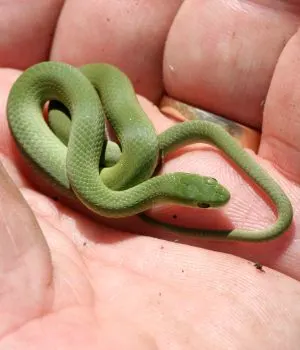
- Experience Level: Intermediate-Advanced
- Family: Colubridae
- Scientific Name: Opheodrys vernalis
- Other Names: Grass snake
- Adult Size: 14-20 inches
- Lifespan: 6 years
- Average Price Range: $30
Smooth Green snakes are medium-sized snakes with bright green and smooth scales. When born they can be olive green, blue-gray and brown. After shedding they turn into a bright green. It’s tongue is red with a black tip, which is used to smell for food.
In months of warm weather green snakes are active day and night in open fields. When winter comes along they hibernate. Smooth green snakes live in woods, meadows, marshes, forests and areas near streams.
This snake rarely bites and flees when in danger. It survives off small insects like moths, caterpillars, slugs and worms. Because smooth green snakes are so small, they are preyed upon by small animals and birds.
30. Great Plains Rat Snake
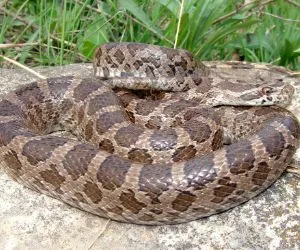
- Experience Level: Intermediate
- Family: Colubridae
- Scientific Name: Pantherophis emoryi
- Other Names: Emory’s pilot snake
- Adult Size: 23-31 inches
- Lifespan: 18-21 years
- Average Price Range: $25-$80
Great Plains Rat Snakes are a rat snake species found in the central United States and Illinois. They are grey with dark edges and blotches covering its back. This snake’s body is medium sized and smooth. They are great climbers and you can often see them in trees.
Great Plains Rat Snakes live in plains, forests and near rivers. They can also be found in rural and rocky areas. Farmlands are also another place they thrive, which is why some call them chicken snakes. Rats and other rodents are a main part of their diet.
Spring through fall is when they are most active. These snakes are nocturnal and if not awake they stay completely still. In barns and under debris are common places they sleep.
31. Black Rat Snake
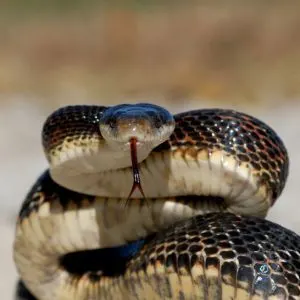
- Experience Level: Intermediate
- Family: Colubridae
- Scientific Name: Pantherophis obsoletus
- Other Names: Pilot black snake, Western rat snake
- Adult Size: 42-84 inches
- Lifespan: 10-15 years
- Average Price Range: $50-$100
Black rat snakes are of subspecies that live in North America, and can be found in many different habitats. This snake prefers heavily wooded areas, but can also live in plains and rocky habitats. It is able to climb high atop trees and able to swim in waters.
These snakes are long and have black smooth glossy scales. Juvenile snakes are grey with dark blotches, as they age they become the infamous black color.
Rats snakes are constrictors and squeeze the life out of their prey. These snakes eat whatever they can get like frogs, squirrels, rats and other small animals.
Rat snakes are common to see in the wild and urban areas. They adapt well to human presence and can help control rodent populations.
32. Gray Rat Snake
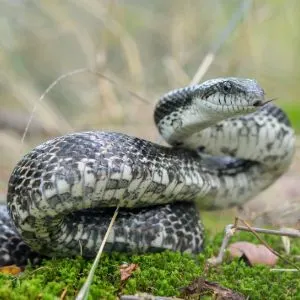
- Experience Level: Intermediate
- Family: Colubridae
- Scientific Name: Pantherophis spiloides
- Other Names: Central ratsnake
- Adult Size: 36-72 inches
- Lifespan: 10-15 years
- Average Price Range: $50-$100
Grey rat snakes are all grey, with dark blotches on their bodies.Younger snakes have no major difference between adults. These snakes are commonly found in forest areas, open fields, and near farms. They travel on the ground or in trees.
Rat Snakes are a strong constrictor snake that preys on small mammals like birds and rats. If you find this snake in the wild they freeze, sometimes shaking their tail to make a small buzzing sound.
Their docile nature and small size make them good pets. They are great for beginners since they are one of the most low maintenance snakes to own.
33. Western Fox Snake
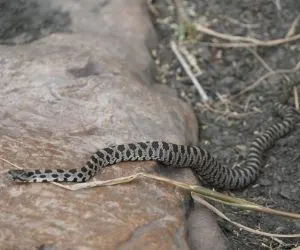
- Experience Level: Beginner-Intermediate
- Family: Colubridae
- Scientific Name: Pantherophis ramspotti
- Other Names: N/A
- Adult Size: 36-60 inches
- Lifespan: 17 years
- Average Price Range: $100-$150
Western Fox snakes are large tan snakes with large dark blotches covering its body. The blotches are black and as they age it can turn a reddish color. The blotches turn into rings when it hits their tails and their belly is a dirty yellow color.
These snakes can be found in the southern forest and fields of Illinois. Areas and prairies with black soil are their preferred habitats. When in danger the fox snake will vibrate its tail rapidly.
People confuse this snake with rattlesnakes, but fox snakes are harmless. This snake is active most in spring and during the day.
Small mammals like mice and rabbits are what this snake eats. It is common to see these snakes hunting or basking in the sun.
34. Eastern Fox Snake
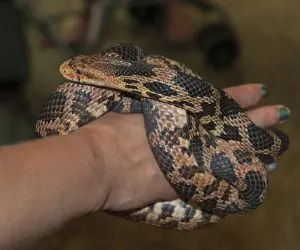
- Experience Level: Beginner-Intermediate
- Family: Colubridae
- Scientific Name: Pantherophis gloydi
- Other Names: Foxsnake
- Adult Size: 36-54 inches
- Lifespan: 17 years
- Average Price Range: $100-$150
Eastern fox snakes are a subspecies of rat snake found in North America and Illinois. These snakes live in marshes and wetlands. They can also be found next to open fields, dry areas and large grasslands. They are often found near water sources and are great swimmers.
Fox snakes are tan with large dark black blotches on their backs. Smaller blotches appear on its side. It’s head is brown with dark bands around its eyes and mouth.
This snake keeps a simple diet of small mammals and birds. It gets its name due to the odor it gives off when handled, which is similar to a fox.
35. Bullsnake
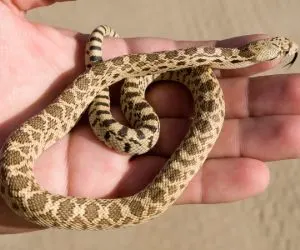
- Experience Level: Advanced
- Family: Colubridae
- Scientific Name: Pituophis catenifer
- Other Names: Gopher Snake
- Adult Size: 48-72 inches
- Lifespan: 12 years
- Average Price Range: $120-$200
Bull Snakes are one of the largest snakes in North America, and are a sub species of Gopher snakes. They can be up to 8 feet and their colors are brown, white, black and reddish with blotching.
Their pattern is large blotches on top with spots on the sides, and rings on their tail.
Bull snakes prefer open fields, prairies, pastures and places with sandy soil. They survive mostly on rodents, birds and small animals. These snakes spend most of their time looking for food and are active in the day.
In winter they hibernate and emerge in spring. It is common to see this snake basking in the sun.
36. Graham’s Crayfish Snake
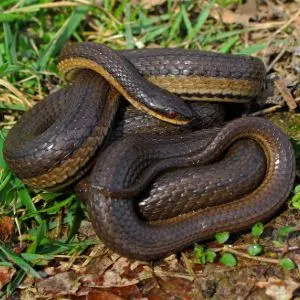
- Experience Level: Advanced
- Family: Colubridae
- Scientific Name: Regina grahamii
- Other Names: Graham’s leather snake, Graham’s queen snake
- Adult Size: 14-24inches
- Lifespan: N/A
- Average Price Range:N/A
Graham’s Crayfish snake is a brownish to gray snake, with a faint mid dorsal stripe. The stripe is yellow, cream or white colored and matches the snake’s belly.
These snakes live in rivers, streams, oxbow lakes and marshes. They can be found in abundance in ditches and areas with lots of crayfish.
These snakes hide under rocks, debris and in crayfish burrows. Graham’s Crayfish snakes eat fish and other amphibians. They are docile and secretive, mostly coming out at night.
It will try to avoid captivity, and will emit a musk when threatened. They are also one of the species to bear live young.
37. Queen Snake
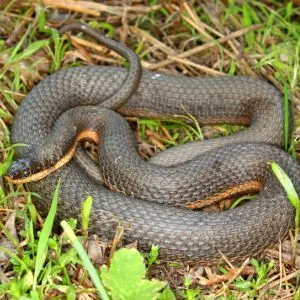
- Experience Level: Intermediate-Advanced
- Family: Colubridae
- Scientific Name: Regina septemvittata
- Other Names: brown queen snake, queen water snake
- Adult Size: 13-36 inches
- Lifespan: 19 years
- Average Price Range: $20-$50
Queen Snakes are a non venomous water snake found in the southern parts of the U.S and Illinois . They are small and thin, with olive, gray or dark brown skin.
Peach or yellow colored stripes run down the sides of its body. When they are young they have extra stripes and patterns. When aged they lose most markings.
These snakes prefer to live in rocky areas with a moving source of water. It searches for its food by smell, and survives mostly on crayfish.Active during spring and most of the day, this snake will begin brumation in winter.
Queen snakes are docile and can be handled easily by experienced snake handlers. They can be nervous and will scare easily.
38. Midland Brown Snake
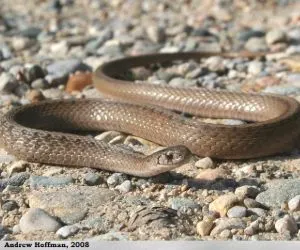
- Experience Level: Beginner
- Family: Colubridae
- Scientific Name: Storeria dekayi wrightorum
- Other Names: De Kay’s Brown Snake
- Adult Size: 9-13 inches
- Lifespan: 7 years
- Average Price Range: $15-$30
Midland Brown snakes are small sized, brownish to gray snakes that live in eastern areas of the U.S. They have a light stripe running down their backs surrounded by spots, and roughkeeled scales.
The top of their head is darker in color. This snake survives off bugs and small invertebrates. Their blunt heads and jagged teeth help remove snails shells when eating.
Midland brown snakes prefer a moist environment. Common places to find them are in marshes, swamps, hillsides and near rivers. They can also be found in gardens, hiding under plants or rocks. They can be beneficial and help kill pests that eat plants.
39. Northern Red-bellied Snake
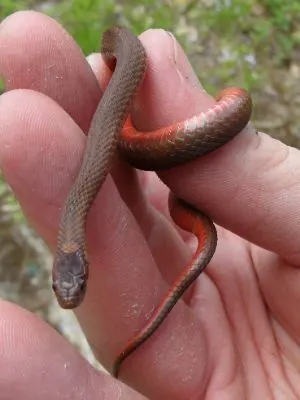
- Experience Level: Advanced
- Family: Colubridae
- Scientific Name: Storeria occipitomaculata
- Other Names: Fire Snake
- Adult Size: 4-16 inches
- Lifespan: 4 years
- Average Price Range: $5
Northern Red-bellied snakes are small and can be olive tan, brown, gray and black in color. They are most known for their bright red belly. They have three dots on their head and keeled scales.
Northern red bellied snakes live in woodlands, flowerbeds and wetland environments. Being so small they only eat earthworms, slugs and small insects.
This snake is very secretive and spends most of its time underground. It is most active from spring to fall and is more likely to come out at night. If handled they will not bite, and will show their teeth, or emit a musk smell.
40. Flat-headed Snake
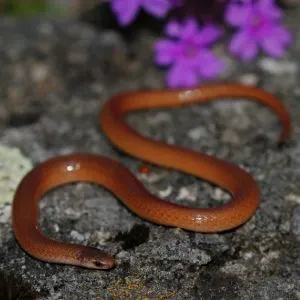
- Experience Level: Advanced
- Family: Colubridae
- Scientific Name: Tantilla gracilis
- Other Names: Centipede snake, Blackhead snake, Flathead snake
- Adult Size: 7-8 inches
- Lifespan: N/A
- Average Price Range: N/A
The Flat-headed snake is one of the smallest snakes that lives in North America and Illinois. Its scales are shiny and brown, with a pink underside. Their heads are dark, wide and flat. In the spring they mate, and in summer they lay eggs.
High moisture and grass, like along the Mississippi river, are common in their living spaces. Rocky and wooded areas with sandy lots are spots they enjoy. Centipedes, other invertebrates, and larvae are a main part of their diet.
Being small this snake is common prey for birds, lizards, other snakes, and small mammals. Flat-headed snakes are a burrowing species, spending most of its time digging in loose soil, and hiding under natural debris.
41. Western Ribbon Snake
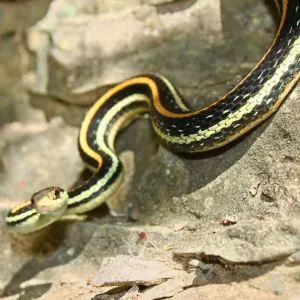
- Experience Level: Beginner
- Family: Colubridae
- Scientific Name: Thamnophis proximus
- Other Names: N/A
- Adult Size: 16-35 inches
- Lifespan: 5-20 years
- Average Price Range: $20-$50
The Western Ribbon Snake is a medium sized garter snake species that is native to Illinois. Compared with other species its body is longer and more slender.
It is colored black with a white, sometimes yellow stomach. Three longitudinal stripes stretch down its back. The middle stirpe is usually orange, and the sides are yellow.
Marshes, woodlands, coastal plains and deserts are some of the habitats it lives in. Most habitats have a similarity of being near water. Active during dusk and dawn, they hunt for tadpoles, frogs, lizards, and other small animals. In hot months they are completely nocturnal.
42. Plains Garter Snake
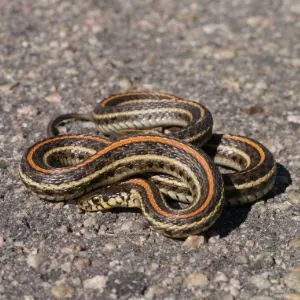
- Experience Level: Beginner
- Family: Colubridae
- Scientific Name: Thamnophis radix
- Other Names: N/A
- Adult Size: 16-36 inches
- Lifespan: 5-10 years
- Average Price Range: $50-200
Plain Garter snakes live in North America and are a sub species of garter snakes. Meadows and prairies next to water is where they enjoy living. They are sometimes found in suburban areas in abandoned buildings and lots.
These snakes have three stripes that go down its back. One orange and two yellow. They are tan to green and sometimes block. They also have black spots in a row by their stripes.
Plain garter snakes are not picky eaters and enjoy eating fish, insects, worms, rats, and sometimes dead animals. Cats, skunks, and hawks enjoy feeding off of garter snakes. You will likely run into these snakes in the daytime.
In winter they hibernate and burrow underground. Garter snakes make great pets because they are small and do not bite. They are not venomous and if threatened they will release a musk smell.
43. Eastern Ribbon Snake
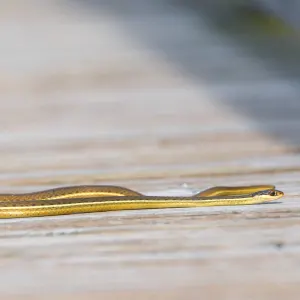
- Experience Level: Beginner
- Family: Colubridae
- Scientific Name: Thamnophis sauritus
- Other Names: Common Ribbon Snake, Blue striped Ribbon Snake
- Adult Size: 18-34 inches
- Lifespan: 12-20 years
- Average Price Range: $25-$50
Eastern Ribbon Snakes are a small and slender snake species found in forests, woodlands, prairies, marshes and areas near bodies of water. They have three stripes that run down its body that can be blue, tan, white and yellow.
Their base color is black, brown or olive green. Spring and heavy rainfall is most likely when they will emerge.
Easter ribbon snakes are active during the day and prey upon fish, frogs, salamanders, and small animals. You can sometimes see them swimming, mouth wide open looking for prey.
These snakes are generally considered harmless and can make great pets.They will not likely bite and release a musk smell when threatened.
44. Northern Ribbon Snake
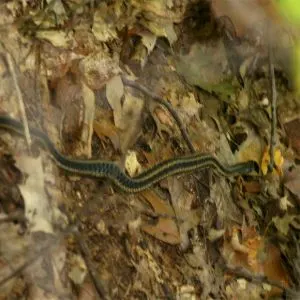
- Experience Level: Beginner
- Family: Colubridae
- Scientific Name: Thamnophis sauritus septentrionalis
- Other Names: N/A
- Adult Size: 18-30 inches
- Lifespan: 12-20 years
- Average Price Range: $25-$50
Northern Ribbon Snakes are a subspecies of ribbon snake that inhabits the southern United States, and are endangered in some areas.
They live in areas with high vegetation and water like marshes, swamps, ponds and streams. They catch most of their prey like frogs, tadpoles and fish in water so they always stay near a source.
Northern Ribbon Snakes use their camouflage to hide from prey and catch food. Different habitats allow for many colors. The snakes are slender with brown or black bodies, sometimes green.
They have three stripes that turn down their back that are light yellow. Their underside is white, yellow, green and sometimes brown.
45. Chicago Garter Snake
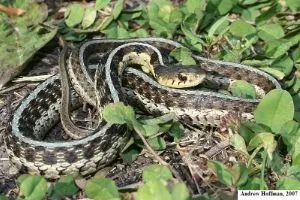
- Experience Level: Beginner
- Family: Colubridae
- Scientific Name: Thamnophis sirtalis semifasciatus
- Other Names: N/A
- Adult Size: 14-36 inches
- Lifespan: 3-10 years
- Average Price Range: $50-200
Chicago garter snakes are a subspecies of garter snake that is native to the area of Chicago Illinois. They are black or tan and medium sized with dark blotches. Yellow stripes run down its back and turn into spots. The break in the snake’s side lines with spotting help identify it from other subspecies.
Chicago garter snakes live in forests and near bodies of water. Garter snakes are cold tolerant and can be seen on warm winter days, and all other seasons.
They eat whatever they comeacross in their habitats like small insects, frogs, mice, bunnies and other small animals. Their bite is harmless and only produces a small amount of venom.
46. Eastern Garter Snake
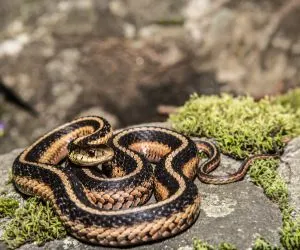
- Experience Level: Beginner
- Family: Colubridae
- Scientific Name: Thamnophis sirtalis sirtalis
- Other Names: dusky garter snake
- Adult Size: 18-26 inches
- Lifespan: 3-10 years
- Average Price Range: $25-$150
Eastern Garter snakes live in grassy woodlands, marshes, hillsides and forests. They can be found hiding under rocks, logs and natural debris, usually preferring more moist and wet areas. In North America garter snakes can be found everywhere and are one of the most common species.
These snakes are brown to olive color, with a dark checkered pattern on their backs. Yellow stripes run down its body and their stomachs are white. Garter snakes are active in both day and night, and are some of the most commonly seen snake species. Earthworms, slugs, frogs, salamanders and other small mammals are preyed upon by these snakes.
47. Lined Snake
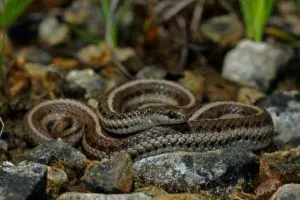
- Experience Level: Beginner-Intermediate
- Family: Colubridae
- Scientific Name: Tropidoclonion lineatum
- Other Names: dwarf garter snake
- Adult Size: 8-15 inches
- Lifespan: 3-10 years
- Average Price Range: $25-$150
Lined Snakes live throughout central Illinois and are mostly active at night. They can be found in open lots and prairies, usually hiding under rocks, logs and other debris.
They have three white or yellowish stripes running down their side and back. Olive brown to black in color, the crescent markings on their white stomach help differentiate from other similar looking snakes like garter snakes.
Lined snakes are rare to see and secretive in nature, active most in spring through fall. They are fossorial. Spending most of their time underground they live in forests and residential areas.
Earthworms and small invertebrates are this snake’s favorite food. In some states they are considered endangered and should be left alone.
48. Western Smooth Earth Snake
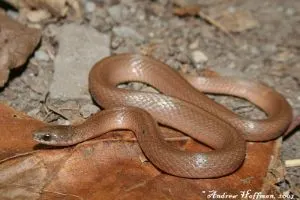
- Experience Level: Intermediate-Advanced
- Family: Colubridae
- Scientific Name: Virginia valeriae
- Other Names: Smooth earth snake
- Adult Size: 7-10 inches
- Lifespan: 9 years
- Average Price Range: N/A
Western Smooth earth snakes are small and brown, with keeled scales. Their belly is white and blends into their back. Black spots also appear on their scales. They have tiny eyes with small black rings around them.
Smooth snakes spend most of their time underground. When not underground they can be found hiding under logs, leaves and rocks. They feed upon earthworms and small soft bodied insects.
This species is active at night and in warmer weather. It is a rare species, and uncommon to spot. Smooth snakes are scattered across the southwest in forests, mountains and the piedmont environments. Instead of laying eggs, this snake can give birth to as many as 14 live young.
49. Western Cottonmouth

- Experience Level: Advanced
- Family: Viperidae
- Scientific Name: Agkistrodon piscivorus
- Other Names: water moccasin
- Adult Size: 24-48 inches
- Lifespan: 10-20 years
- Average Price Range: N/A
Western Cottonmouths are a semi aquatic venomous snake found in the southern United States. The bright white skin inside of their mouths is what gives them their name.
Cottonmouths are medium-sized with thick bodies. Their colors are dark grey to tan and have no markings. As they age they grow darker, some even becoming all black. They have broad heads and cat-like eyes.
These snakes are semi aquatic and enjoy living in swamps, rivers, lowland plains and grassy areas near water. In spring or fall they move further away from water. Fish, salamanders, birds and lizards are what these snakes survive off of, mainly hunting at night.
50. Timber Rattlesnake
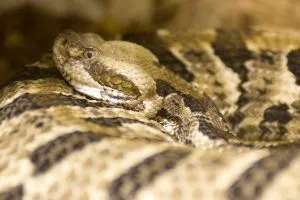
- Experience Level: Advanced
- Family: Viperidae
- Scientific Name: Crotalus horridus
- Other Names: timber rattler
- Adult Size: 30-60 inches
- Lifespan: 10-20 years
- Average Price Range: $300
Timber Rattlesnakes are a venomous pit viper species found in the southeastern parts of the United States. Rocky forests, ledges and hills are common habitat traits. These snakes travel long distances and in summer they move to more grassy habitats.
Timber Rattlesnakes are grey, with a line stripe that runs down the middle of their back. Chevron stripes also go down their backs, with brown coloring to help with camouflage.
Their venom is extremely deadly and their rattle can help warn of an impending strike. Small rodents, birds, lizards and amphibians are what this snake eats.
They catch their prey by hiding out and ambushing them. Destruction of natural habitat and predators has caused the population decline of this species.
51. Eastern Massasauga
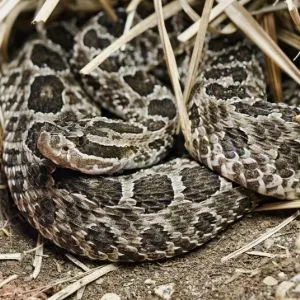
- Experience Level: Advanced
- Family: Viperidae
- Scientific Name: Sistrurus catenatus
- Other Names: massasauga rattlesnake, black massasauga
- Adult Size: 24 inches
- Lifespan: 14 years
- Average Price Range: $300
Eastern Massasaugas are a rattlesnake species that are smaller in size and
population. They can be found in wetland and upland habitats in Illinois and other parts of eastern North America. They are grey or tan, with black blotches covering their body. A small rattle sits at the end of their tail, and their underside is all black.
These snakes are extremely venomous and make a buzzing sound when threatened. Moles, shrews, lizards,birds and other small mammals are what this snake feeds upon.
Eastern Massasaugas are sadly endangered, and are becoming harder to find. Destruction of the coastal plains and wetland habitat has contributed to their population decline. Along with predators like boars and birds.
Wrapping up
Illinois has over 50 snakes that live in various habitats. Some of them are endangered and face extinction. Destruction of habit and killings are common factors of each species decline. Snakes that rely on water can die if their water source is destroyed or polluted. Many people kill snakes thinking they are a venomous species.
These killings along with natural predators, and illegal capturings can lead to their decline. Preserving habits and educating people about snakes can make sure their population remains healthy. Healthy populations mean many snakes to find in the wild while herping.
Snakes can make great pets and Illinois has many friendly species. Kingsnakes, milk snakes, garter snakes and ring necked snakes are species native to Illinois that make great beginner pets. These snakes are less likely to bite and adapt well to captivity. Other snakes like copperheads can be harder to keep but are valued as a species. If getting a pet you should research your species thoroughly.
The many snakes in Illinois makes it a great state for reptile lovers. Each habitat gives a variety of snakes. Hopefully this list will help you on your herping adventures in Illinois.
Snakes in Other States
